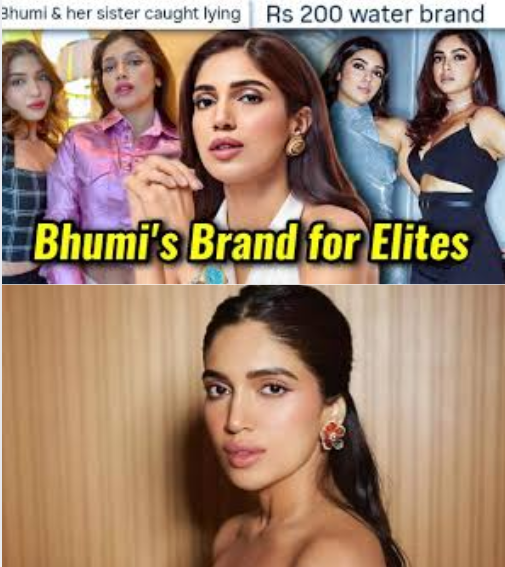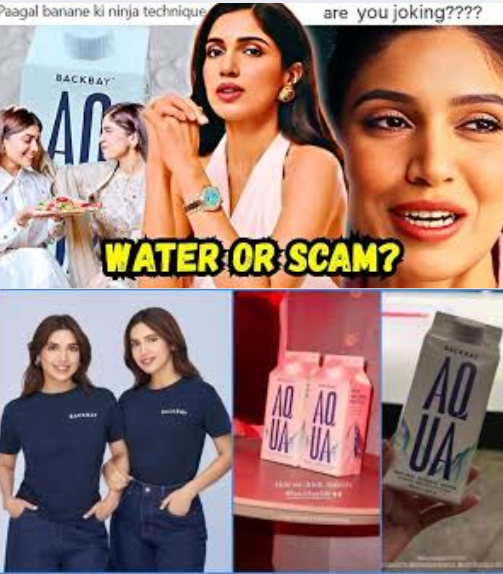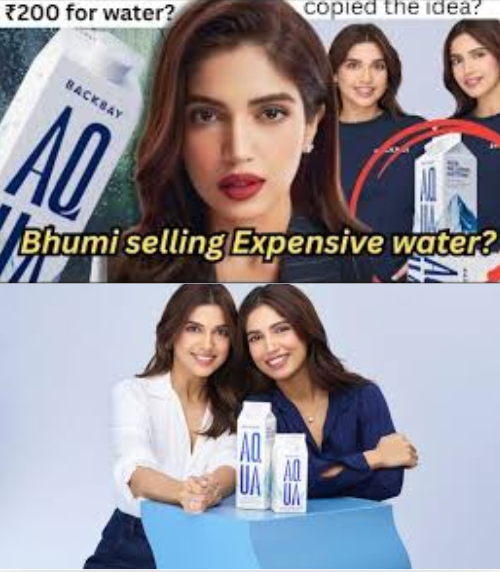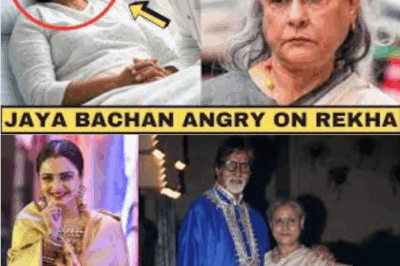BHUMI PEDNEKAR’S PREMIUM WATER BRAND: TALKING ABOUT SUSTAINABILITY & THEN EXPLOITING RESOURCES
In recent times, celebrity-owned brands have increasingly entered non-traditional markets, often drawing attention for their novelty, intent, or controversy. One such recent launch has been the premium bottled water brand introduced by Bollywood actress Bhumi Pednekar. Priced at ₹200 per bottle, this product has quickly stirred conversations across social media, not just for its price tag, but also for the message it carries. Bhumi, a well-known actor and environmental advocate, has described the brand as both premium and sustainable, while simultaneously claiming it to be “accessible” — a term that sparked backlash and confusion.
To understand this entire situation, it’s important to first recognize the positioning of the brand. Bhumi Pednekar’s water brand is not meant to compete with ₹20 bottled water brands like Bisleri, as many assumed at first glance. Instead, it aims to cater to a niche segment — the premium, elite consumer base that sees bottled water as a lifestyle and status product, not just a necessity. This segment is already served by brands like Evian and Voss, both of which are known for their premium pricing and luxury positioning. These international brands, often seen in five-star hotels, upscale events, and luxury retail spaces, have long marketed themselves not just as water providers, but as lifestyle enhancers.
Bhumi’s brand, sourced from Himalayan springs and packaged with careful attention to design and sustainability, is attempting to tap into this exact space. The brand boasts that it is not contract-manufactured but produced entirely in-house, with a dedicated bottling facility in Himachal Pradesh. This kind of ownership allows for greater control over quality and processes, potentially enabling better adherence to sustainability practices. The brand claims a production capacity of 45,000 boxes per day, suggesting significant operational scalability.
However, despite all this, a core communication problem remains. Bhumi and her team have repeatedly used words like “accessible” and “our childhood dream” in promotional materials and interviews. When a ₹200 bottle of water is described as “easily accessible for everyone,” it’s understandable that audiences find it contradictory. In a country where basic access to clean drinking water is still a challenge for many, calling a luxury product “accessible” rings tone-deaf and disingenuous.

This is not just a case of miscommunication — it’s a mismatch between brand positioning and brand messaging. Audiences today are more aware and more vocal. Inconsistent messaging does not go unnoticed. The backlash on Bhumi’s promotional reels and interviews highlights this growing consumer consciousness. Comments questioning how a bottle of water priced at ten times the average could ever be called “accessible” flooded her social media posts. Viewers called out the apparent elitism, with many pointing out that such products reinforce the gap between the rich and the middle or working classes.
Yet, it’s also important to assess the business model objectively. Premium bottled water is not new. Evian, Voss, Perrier, and other such brands have been selling water at premium prices for decades. These brands have positioned themselves not as alternatives to daily hydration, but as symbols of class, purity, or luxury. Consumers at high-end events, fashion shows, climate-related seminars, or elite gatherings often prefer aesthetically pleasing and environmentally conscious packaging over the standard plastic bottles found in corner shops. In these environments, Bhumi’s brand fits in well.
Moreover, sustainability does seem to be a central theme in the brand’s narrative. The product claims to be sourced responsibly from Himalayan springs and aims to reduce plastic waste through better packaging. In events such as the Gaurav Gupta fashion show, the brand was reportedly used as the official water partner, signaling a strategic association with other premium, design-forward labels.
However, claiming sustainability and delivering it are two different things. When a company promotes itself as environmentally friendly, it invites scrutiny regarding every part of its supply chain. In the case of Bhumi’s brand, it has raised genuine concerns about the ecological impact of extracting water from Himalayan springs and setting up bottling facilities in ecologically sensitive zones like Himachal Pradesh. Multiple reports in the past have detailed how mineral water plants can harm natural habitats, disrupt ecosystems, and endanger local species due to excessive water extraction.

This brings us to the core contradiction — promoting environmental protection while commodifying a natural resource like water. The idea that “clean water should be sold at a premium” sits uncomfortably with the advocacy for sustainability and ecological protection. Consumers today expect transparency. It’s not enough to say the brand is different from others because “we care.” Brands must be willing to show, through clear documentation, third-party audits, and real community impact, how exactly they care.
Questions like “what environmental impact assessments were conducted before setting up the plant?”, “what measures were taken to preserve the local ecology?”, and “how much water is drawn daily compared to local consumption needs?” are valid. And Bhumi’s team, if they truly want to be seen as leaders in the sustainable luxury space, should welcome and address such inquiries openly. Avoiding them, or brushing them off as negativity, only fuels skepticism.
This situation is not without precedent. Other celebrity-led brands have faced similar scrutiny. Deepika Padukone’s skincare brand, for instance, was criticized for high pricing and lack of relevance to Indian climates and skin types. Unlike Katrina Kaif’s or Kriti Sanon’s beauty ventures, which engaged with consumer feedback and emphasized product development suited to Indian consumers, Deepika’s brand was seen as unapproachable and disconnected. As a result, it failed to gain the same kind of traction or public support.
Meanwhile, brands like Haeven, despite receiving backlash initially for their high price points, won consumer trust by engaging directly with feedback, improving their formulations, and building a narrative around quality. That kind of responsiveness matters. In Bhumi’s case, the perception that her team is tone-deaf, using vague terms like “childhood dream” and “accessible luxury,” without addressing environmental concerns directly, is harming the brand more than the pricing ever could.
There’s also a broader issue at play: the optics of selling water. Water, by its very nature, is a shared resource — a public good. Turning it into a luxury item is bound to raise moral and ethical questions, especially in countries where access to clean water is not yet universal. Even when positioned as a lifestyle product, brands must be cautious not to appear exploitative or out of touch. Using nature for profit is not wrong in itself, but doing so under the guise of sustainability while ignoring deeper environmental implications is what the audience finds troubling.

At the end of the day, the brand’s survival will depend not just on celebrity clout or design aesthetics, but on how well it can bridge the gap between its ideals and its actions. Is this a truly sustainable product? Has the ecological cost been minimized? Can a premium product also be ethical? These are the questions that need answers.
Bhumi Pednekar’s celebrity status has amplified the scrutiny, but it’s also an opportunity. If her team can address public concerns transparently, improve messaging, and demonstrate genuine efforts in protecting ecosystems, her brand can stand out as a pioneer — an Indian luxury brand with integrity. But if these questions are ignored, the brand risks becoming another example of greenwashing and elitist branding in a market that no longer accepts surface-level claims.
In conclusion, Bhumi’s water brand has sparked a much-needed conversation about the intersection of luxury, sustainability, and privilege. It’s a reflection of how today’s audiences expect more than glossy marketing — they demand responsibility, ethics, and transparency. The coming months will show whether the brand can rise to meet those expectations or become a cautionary tale in the era of conscious consumerism.
Play video :
News
Why did Hema Malini leave ailing Dharmendra alone at the last moment? Dharmendra Sad News, Hema Malini
Why did Hema Malini leave ailing Dharmendra alone at the last moment? Dharmendra Sad News, Hema Malini . . ….
Pregnant Katrina Kaif Blessed with A Baby after her Secret Pregnancy with Vicky Kaushal in London!
Pregnant Katrina Kaif Blessed with A Baby after her Secret Pregnancy with Vicky Kaushal in London! . . . Katrina…
Amitabh Bachchan Wants To Support Rekha By Marrying Her In Hospital
Amitabh Bachchan Wants To Support Rekha By Marrying Her In Hospital . . . Amitabh Bachchan’s Heartfelt Decision: Supporting Rekha…
Jaya Bachchan Upset On Amitabh Bachchan Decision Of Marriage With Rekha
Jaya Bachchan Upset On Amitabh Bachchan Decision Of Marriage With Rekha Spoken in a tone that blends empathy with quiet…
Dharmasthala mass burial case: SIT Expands Search, Supreme Court Denies Media Gag
Dharmasthala mass burial case: SIT Expands Search, Supreme Court Denies Media Gag The Special Investigation Team (SIT) probing the Dharmasthala…
Dharmasthala: No Exhumation Today, Kannada channels under scanner
Dharmasthala: No Exhumation Today, Kannada channels under scanner The Karnataka police have registered seven First Information Reports (FIRs) in connection…
End of content
No more pages to load







